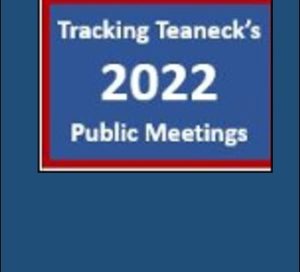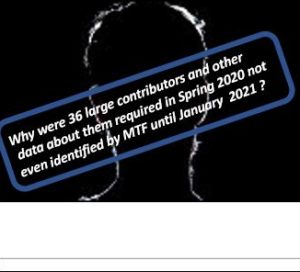Following Good and Welfare at the 4/13/2021 Regular Council meeting, Mayor Dunleavy turned to the Attorney Shahdanian for what the Mayor said would be the “last word, the legal word” on the continuing controversy about alleged pay-to-play violations stemming from a 4/23/2020 contribution of $900 to Teaneck’s winning Council slate made by the Managing Partner, Michele Delisfort, of the Nishuane Group of Montclair.
On July 1, 2020 – at its organizational meeting – the new Council unanimously passed a resolution which was officially titled “AUTHORIZING THE NISHUANE GROUP, LLC TO UNDERTAKE PLANNING CONSULTANT SERVICES ON BEHALF OF THE TOWNSHIP OF TEANECK AS ALTERNATE PLANNERS” for one year. The resolution clarified that the Teaneck manager had certified that anticipated fees under the contract would be more than $17,500 and that the Nishuane contract was a no-bid one utilizing the exemption that some professional services contracts are allowed to be “non-fair and open” and thus avoid any bidding process. The Council resolution itself asserts that Nishuane had submitted a proposal – but the Clerk’s office now, after considerable delay, concluded that no such proposal exists. Already, very strange stuff!
This Council resolution narrative for this 7/1/20 Nishuane contract stated that the Nishuane firm and its partners had already signed a statement certifying that neither it nor any of the firm’s owners/partners had made any reportable contribution to candidates in Teaneck elections for the previous 12 months.
But WAIT – THAT’S NOT TRUE! Except no one knew it! Why? Because the winning Council slate (Moving Teaneck Forward – Orgen, Pagan and Schwartz) had not provided any report to the State identifying Managing Partner Delisfort’s $900 contribution until it filed a very late amended report disclosing the contribution on January 21, 2021. Hence, the controversy about whether the Nishuane contract is legal is of relatively recent vintage.
TTT believes it is useful to allow public officials to speak for themselves. Accordingly, what follows below is a 4-minute video in which the Attorney gives his response to the Mayor’s request for a discussion of the Nishuane situation .
You will hear 3 basic points:
1) That the Nishuane contract was not actually a contract – only a document;
2) That the State meant – but neglected actually to say – that multiple candidate committees don’t have to report contributors the same way as single candidate committees do. So the attorney proposes to “remedy” that problem, with the ridiculous suggestion that with the Latin dictum, (in pari materia), he could rewrite the law – “fixing it” – simply by claiming that the legislature meant to “merge” things it did say in different places but itself had failed to combine;
3) That the attorney claims he is responding to incompetent/untrained, “ridiculous/outrageous” Teaneck residents who wrongly say that Nishuane’s contract is an instance of pay-to-play.
(Our very critical analysis of this 4/13/2021 Council statement follows below the video.)
A Critical Response: Let’s cut to the chase.
Attorney Shahdanian is claiming that Nishuane’s Managing Partner, Ms. Delisfort, did nothing wrong when she signed a political contributions document that said she had not made any – let alone a reportable – contribution to the Moving Teaneck Forward (MTF joint-candidate committee in last May’s municipal election for Council. In its late January 2021 filings,, MTF reports for the first time having received a $900 contribution from Ms. Delisfort.
Now the Attorney surely knows that any contributor of more than $300 to a candidate for town office must be named in campaign reports to the State. (NJAC 19:25-10.2) The $300+ threshold for required reporting is true for a donation to any NJ campaign committee – irrespective of whether the recipient campaign committee is for a single candidate or for several candidates.
And the entire relevant official election literature of the State and its municipalities speak with one voice about this $300+ contribution reporting threshold — whether it be the state election statutes (NJSA 19:44A-16), its election regulations (NJAC 19:25-10.2)) and ELEC’s candidate compliance manual (p. 22-3). And that same threshold ($300+) is found also in Teaneck’s own revised pay-to-play code (Ordinance 19-2017) . Indeed, the same $300+ threshold can also be found in the the Council’s resolution narrative that authorize ALL of the the town’s recent town no-bid contracts with professional entities.
All these official sources agree that a candidate campaign committee of any size or number of candidates owes a timely report to the State (ELEC) for each of these $300+ donations – a report that lists the contributor’s name, address, the contribution amount, date it was received, the donor’s employer’s name and address and the donor’s occupation.
Ever since the public became aware of the disclosures made to ELEC in the five January 21, 2021 MTF slate’s reports, (and in particular the revelations about how much of MTF’s revenue had come from large non-Teaneck contributors) there has been an effort by MTF and its allies to assert that its huge list of $900 contributors were not, in fact, reportable because those contributions should be divided by 3 – one for each candidate and thus that none were “more than $300″ .
This claim is, of course, best refuted by the fact even the MTF’s own most recent amended reports – particularly the amended MTF 29-day and 11-day pre-election reports – fully reported the required data on several $500 contributions as well as all of the many $900 ones in which those contributors had so much later just been disclosed. The initial claim was that something referred to as the Equal Attribution Rule would allow or even require that contributions to the 3-candidate MTF slate should be equally divided among the three candidates to determine when a report was required. The false argument: $900 divided by 3 = $300 even, not more than $300 – so no report.
Actually, the equal attribution rule language was never cited or referenced in any of the State’s legal discussions of when the $300+ contributors had to be reported timely to ELEC. In fact, the so-called “Equal Attribution Rule” actually appears in only one place in the state’s official election literature although the term “equal attribution requirement” shows up briefly also in the NJ Administrative Code.
There is nothing about such a “rule” in any state election statute — and every single reference suggesting any equal division of contributions that appears anywhere in the state election literature has to do with how to make sure that large donors are not using innovative calculation methods that rely on an unequal division of candidates in multiple (i.e. joint) candidates committee to boost their allowable cap on contributions in any election. Contribution reportability and contribution caps ARE ALWAYS AND EVERYWHERE separated in state election law statutes and discussions.
If an equal attribution rule idea could allow equally dividing the $900 among the 3 MTF candidates, that would mean than Ms. Delisfort’s contribution – like the other twenty-eight $900 contributions to MTF revealed in the 1/21/2021 ELEC reports – were attributable at exactly $300 to each candidate and thus not reportable. The reason attention focused on the Delisfort case was that her late April 2020 contribution was soon followed by the 7/1/2020 contract to her Nishuane firm.
But alas, any reportable contribution to a Council candidate for town office made Ms. Delisfort’s firm legally ineligible for the contract Nishuane had just been given. That ineligibility was clear in the pay-to-play laws of the State and of the Town and blatantly clear on the political contributions forms and even in the executed contract that Delisfort signed on 7/1/2020.
Query: should one at least assume that the 3 MTF candidates and MTF’s president/treasurer, Gerald Reiner, had known of the problems posed by the Delisfort contribution when these new Council members – as part of a new Council – unanimously approved the Nishuane contract?
Their 5/1/20 signatures on the original MTF 11-day pre-election report to ELEC claimed that they did as know since each signed this statement: “I certify that the statements on this document are true, and that the contribution amounts received conform with the limitations designated by law”.
What has happened more recently with this Nishuane issue in the early months of 2021 – may be a case of official disingenuousness. The Mayor, Councilman Kaplan and the Town Attorney – particularly beginning in the Council meeting on March 25 – decided to weigh into the middle of this Nishuane controversy. None of them were principals in the original mess. (A prior Teaneck Transparency post discusses the Mayor’s 3/25 statements click here.) But these officials apparently decided to make it their fight, as well.
In this post we focus on the shocking 4/13/2021 performance by the Attorney that you have just witnessed in the video above.
Mr. Shahdanian clearly recognizes what we have just reviewed: the State’s requirement that candidate committees report to ELEC the contributors of a $300+ contribution by any and all candidate campaign committees in unambiguous!
Next, he makes two self-evidently fallacious arguments to try extract the Nishuane Group from having illegally taken the Teaneck contract to become the Town’s alternate planner. 1) It wasn’t a contract; and 2) If you read the state’s legal stuff in his way the State didn’t REALLY mean to say that any $300+ contribution had to be reported when 3 candidates ran together – so no harm no foul. Let’s check:
First, Mr. Shahdanian claims Nishuane did not actually sign a contract. Listen carefully! The attorney says that what Nishuane signed was only a “document” in which Nishuane agrees to be the Town’s alternate planner. No specific assignment. So – he says – it was not a contract!
Not a contract? It is described as a contract throughout the Council’s approving resolution and the actual fully-executed contract which throughout repeatedly defines itself as a contract.
Next was the argument seen in the video as Shahdanian claims it was not a real contract, because the authorizing Council resolution did not specify specific Nishuane projects. The problem with that Shahdanian argument is that the Town’s regular planning firm, Phillips, Preiss et. al., had received its annual contract that same day (7/1/20) and its wording is exactly identical to Nishuane’s. Preiss has been getting paid hefty sums on that identically-worded annual contract ever since. One suspects that the Attorney has not yet told Mr. Preiss he does not have a contract!
(Incidentally, earlier – in March – Township officials had claimed the Nishuane contract had “not been fully executed”. That claim disappeared when residents showed that they had received – in response to an OPRA request – what the Clerk’s office had described as “a fully executed contract”.
When that document – with the Mayor’s and Ms. Delisfort’s signatures attested by the Clerk appeared on social media, the charade that it was “not fully executed” disappeared.)
2) NEXT ARGUMENT Per the video – and without a transition – except to excoriate resident comments – Shahdanian moves on to what other attorneys have described as a piece of true casuistry.
Shahdanian knew full well that the State’s only “Equal Attribution Rule” discussion was not found in any State statute. In fact, its only appearance was as a phrase in the ELECs own “Compliance Manual for Candidates which the Commission uses to explain how it plans to enforce actual law and regulation.
By contrast, as we saw above – the “$300+ contribution = you must report it” rule was repeated without qualification anywhere – in NJ State statute, in NJ State Administrative Code and the ELEC Compliance Manual for Candidate.
So in the video, Shahdanian suddenly introduces a little Latin – the doctrine of in pari materia which, he says, means “you can’t read statutes individually, you have to read statutes together”. That definition, actually, is not far off. In pari materia does refer to how to relate two separate statutory discussions that are “on the same subject”. It “is a doctrine used in interpreting statutory construction when statutes actually are in pari materia and “should be construed together”. (Webster et al.)
But for the doctrine to be relevant, the statutes have to meet the in pari materia criteria. The problem for Shahdanian is that in this case he does not even have two statutes which are “on the same subject”:
1) not even two statutes: – The attorney can cite a phrase about “equal attribution” from an ELEC compliance manual. But he wants to elevate that passage to being a statute – so it can invalidate the actual, statutory $300+ disclosure rule. So he makes stuff up! At 3:04 of the video, Shahdanian even refers – completely erroneously – to there being “another ELEC statute”. Plain and simple, there is no ELEC statute about an equal attribution rule; there is only ELEC commentary on the meaning of an actual NJ statute addressing a completely different issue.
2) not the relevant threshold The ELEC discussion about the Equal Attribution Rule” IS about how to find a threshold – but its a threshold designed to keep big-dollar donors from being able to give more money than the legislature wanted to allow, not a threshold about when a candidate committees that receive contributions of a specific size, must publicly report their contributors and the actual size of those $300+ contributions.
Shahdanian makes some reference in introducing the in pari materia doctrine to there being something about a “corollary to that”- but fails to tells us what it is to which there is a corollary. To what or why is anything a corollary in this context? Babble!
At this point the Township attorney’s language has become completely incoherent. He then claims it would be “illogical” for the election statutes not to use the same “equal attribution rule” in both places. That assertion is, of course, itself without foundation OR logic. If this “attribution” phrase which in one place was meant to help enforce contribution limitations were meant also to re-define the $300+ threshold for contribution reporting, then somewhere in the legislative process or in the regulatory pieces which followed from it or in the development of guidance to electoral candidates in a compliance manual there would have been some hint that $300+ could mean something different than $300+ if only there were multiple candidates in a joint-candidate committee. Shahdanian believe it is “illogical” for the “equal attribution” term to NOT be applicable to both issues. There is no known logic that require a concept that explicitly applies to one context to be applicable also in a completely different context!
As it stands, Shahdanian’s are unintelligible assertions to establish a legal interpretation which is totally flawed and doing being led to intervene in an Town election law issue about which he should not as Town Counsel be opining anyhow.
3) But before we leave this Shahdanian video, there is a third element. More than 1/3 of Mr. Shahdanian’s video speech is devoted to belittling the Teaneck residents who have raised this pay-to-play issue – and specifically residents Alan Sohn and Charles Powers.
In what follows we quote some of those vitriolic Shahdanian personal attacks on these residents and simply place them in juxtaposition with what are Powers’ own work and experience and accomplishments in respect of some of the specific areas where Seton Hall law graduate Shahdanian finds him to be “ridiculous.”
____________________________________________________________________________________________
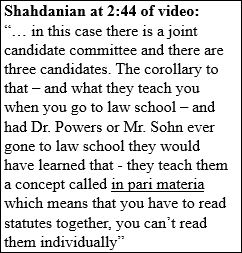
Teaneck resident Charles Powers, Ph.D. first taught the concept of in pari materia to a class at Yale Law School entitled Yale’s Investments in 1969. The majority of the students were 2nd year Yale Law Students – and the remainder were from graduate and professional schools throughout the University. The course was one which the Yale Corporation had specifically requested Powers and two others to create and teach.
Powers was the youngest of the course’s teaching trio, the other two being John G. Simon, Yale’s Lines Professor of Law emeritus and Yale’s late James Tobin, Economics Nobel Laureate.
The central issue in this Yale course was whether a university investor could be said to “cause” social injury by owning particular stocks. Guided by Oxford’s HLA Hart’s, Causation in the Law, the faculty had focused on two statutes which, though separate, initially appeared to meet the in pari materia criteria. They were statutes superficially about the same material – the same “stuff”. But Powers researched and then taught that a serious student of the law could not use these two statutes to help interpret each other – that in pari materia was a doctrine with very limited utility in serious legal scholarship where sound statutory interpretation was required.
This Yale’s Investments course led to a 1972 Yale University Press book of which Powers is one of the three authors, The Ethical Investor: Universities and Corporate Responsibility. The detailed guidelines in the back of that book were adopted in their entirety by the Yale Corporation in the Spring of 1972 and remain virtually unchanged as Yale’s social investment policy now 49 years later. Powers chaired the first University committee to apply those guidelines in the University’s investment decisions.
Over nearly 5 decades the guidelines have now been used to decide how the university would address investment issues embedded in decisions about South Africa, defense contracting, political lobbying, environmental and worker safety, climate change and hydrocarbon production.
The University still in 2021 views the legal and ethical reasoning in the Ethical Investor as the best guide to understanding those same Yale Guidelines today. The University has, therefore, made The Ethical Investor book freely available to be downloaded from a university website where the University’s current Advisory Committee on Investor Responsibility is described as well. See https://acir.yale.edu/
Powers has followed scholarship on in pari materia ever since when subsequently teaching law and other professional school students in 3 other first-line universities. There he often highlights the persistent misuse of in pari materia by attorneys trying to save failed arguments by proposing to combine statutes and extraneous dicta which are not “in pari materia”. And the fault is usually that statutes and other legal narrative that appear superficially to be about the same thing are very rarely really the same “materia”– and thus whatever two passage are being cited are very rarely worthy of helping interpret each other.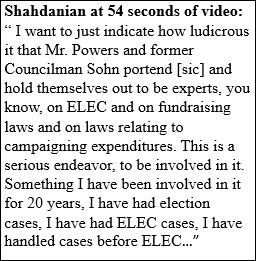
Some 25 years later, Supreme Court Justice Stephen Breyer-to-be and Charles Powers worked as colleagues on the Carnegie Commission on Science, Technology and Government [1988-1993], an institution on whose Advisory Council Powers sat and for which Commission he was lead author on several of its major papers. In 1992 Breyer delivered Harvard’s Oliver Wendell Holmes Lectures, which became Breyer’s 1973 Harvard Press book, Breaking the Vicious Circle: Toward Effective Risk Regulation. This book is generally credited with having led to 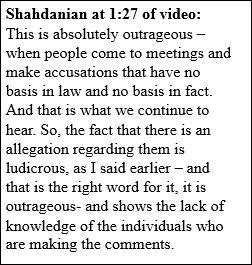 Breyer’s Supreme Court nomination and confirmation in 1994. In the Preface to the Vicious Circle Breyer credits Teaneck resident Powers as one of the 5 “scientific and regulatory experts” who made his book possible. Articles on regulatory policy and institutions by Powers are cited frequently throughout Breaking the Vicious Circle..
Breyer’s Supreme Court nomination and confirmation in 1994. In the Preface to the Vicious Circle Breyer credits Teaneck resident Powers as one of the 5 “scientific and regulatory experts” who made his book possible. Articles on regulatory policy and institutions by Powers are cited frequently throughout Breaking the Vicious Circle..
Powers is the only person ever to be recommended for a faculty appointment by a sitting Supreme Court Justice to a Rutgers University medical school. Supreme Court Justice Stephen Breyer wrote that recommendation in 1995 to the appointments committee of what was then the Robert Wood Johnson Medical School (RWJMS) Powers was named full professor of Environmental and Community Medicine at RWJMS that year and then became full professor of Environmental Engineering in the Department of Civil and Environmental Engineering in Vanderbilt’s Engineering School in 2006. Earlier he also served on the faculties of Yale and Harvard Universities and Haverford College. He retired from Vanderbilt in 2015.

